OCZ Octane 128GB SSD Review
by Anand Lal Shimpi on December 28, 2011 12:27 AM ESTAnandTech Storage Bench 2011
Last year we introduced our AnandTech Storage Bench, a suite of benchmarks that took traces of real OS/application usage and played them back in a repeatable manner. I assembled the traces myself out of frustration with the majority of what we have today in terms of SSD benchmarks.
Although the AnandTech Storage Bench tests did a good job of characterizing SSD performance, they weren't stressful enough. All of the tests performed less than 10GB of reads/writes and typically involved only 4GB of writes specifically. That's not even enough exceed the spare area on most SSDs. Most canned SSD benchmarks don't even come close to writing a single gigabyte of data, but that doesn't mean that simply writing 4GB is acceptable.
Originally I kept the benchmarks short enough that they wouldn't be a burden to run (~30 minutes) but long enough that they were representative of what a power user might do with their system.
Not too long ago I tweeted that I had created what I referred to as the Mother of All SSD Benchmarks (MOASB). Rather than only writing 4GB of data to the drive, this benchmark writes 106.32GB. It's the load you'd put on a drive after nearly two weeks of constant usage. And it takes a *long* time to run.
1) The MOASB, officially called AnandTech Storage Bench 2011 - Heavy Workload, mainly focuses on the times when your I/O activity is the highest. There is a lot of downloading and application installing that happens during the course of this test. My thinking was that it's during application installs, file copies, downloading and multitasking with all of this that you can really notice performance differences between drives.
2) I tried to cover as many bases as possible with the software I incorporated into this test. There's a lot of photo editing in Photoshop, HTML editing in Dreamweaver, web browsing, game playing/level loading (Starcraft II & WoW are both a part of the test) as well as general use stuff (application installing, virus scanning). I included a large amount of email downloading, document creation and editing as well. To top it all off I even use Visual Studio 2008 to build Chromium during the test.
The test has 2,168,893 read operations and 1,783,447 write operations. The IO breakdown is as follows:
| AnandTech Storage Bench 2011 - Heavy Workload IO Breakdown | ||||
| IO Size | % of Total | |||
| 4KB | 28% | |||
| 16KB | 10% | |||
| 32KB | 10% | |||
| 64KB | 4% | |||
Only 42% of all operations are sequential, the rest range from pseudo to fully random (with most falling in the pseudo-random category). Average queue depth is 4.625 IOs, with 59% of operations taking place in an IO queue of 1.
Many of you have asked for a better way to really characterize performance. Simply looking at IOPS doesn't really say much. As a result I'm going to be presenting Storage Bench 2011 data in a slightly different way. We'll have performance represented as Average MB/s, with higher numbers being better. At the same time I'll be reporting how long the SSD was busy while running this test. These disk busy graphs will show you exactly how much time was shaved off by using a faster drive vs. a slower one during the course of this test. Finally, I will also break out performance into reads, writes and combined. The reason I do this is to help balance out the fact that this test is unusually write intensive, which can often hide the benefits of a drive with good read performance.
There's also a new light workload for 2011. This is a far more reasonable, typical every day use case benchmark. Lots of web browsing, photo editing (but with a greater focus on photo consumption), video playback as well as some application installs and gaming. This test isn't nearly as write intensive as the MOASB but it's still multiple times more write intensive than what we were running last year.
As always I don't believe that these two benchmarks alone are enough to characterize the performance of a drive, but hopefully along with the rest of our tests they will help provide a better idea.
The testbed for Storage Bench 2011 has changed as well. We're now using a Sandy Bridge platform with full 6Gbps support for these tests.
AnandTech Storage Bench 2011 - Heavy Workload
We'll start out by looking at average data rate throughout our new heavy workload test:
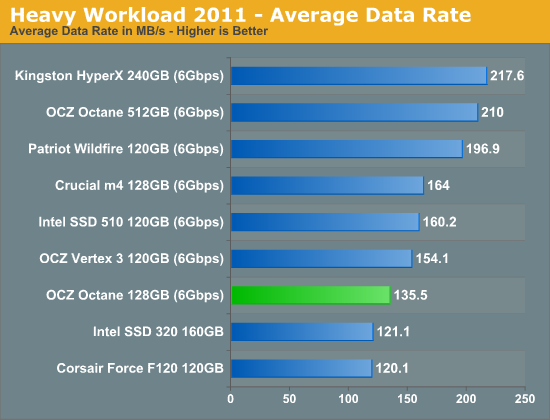
For write-heavy workloads the 128GB Octane is faster than the previous generation 3Gbps drives, but still a bit slower than the 6Gbps Intel, Crucial and SandForce based offerings.
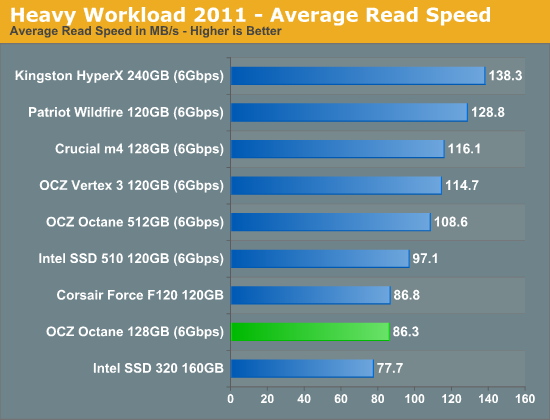
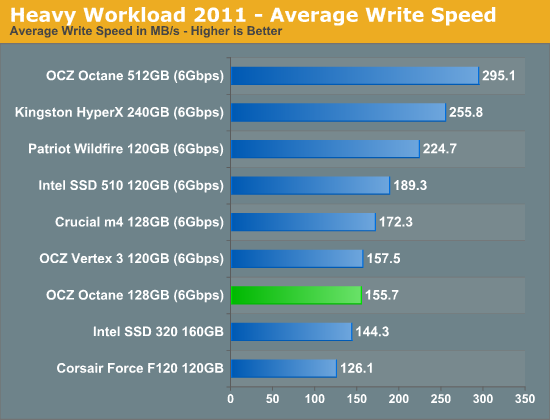
The next three charts just represent the same data, but in a different manner. Instead of looking at average data rate, we're looking at how long the disk was busy for during this entire test. Note that disk busy time excludes any and all idles, this is just how long the SSD was busy doing something:
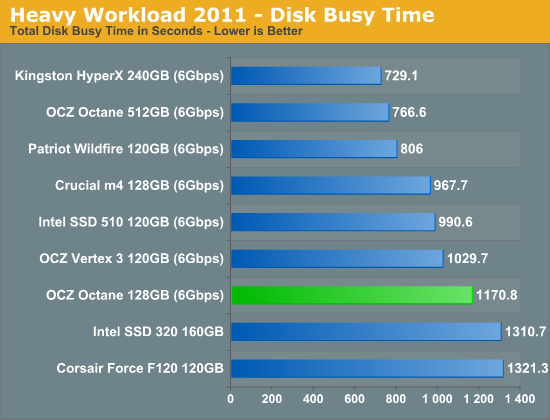
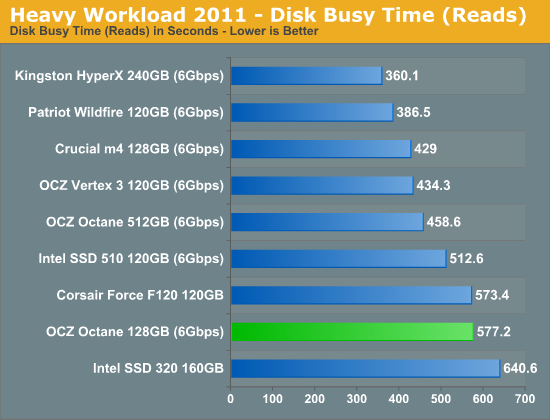
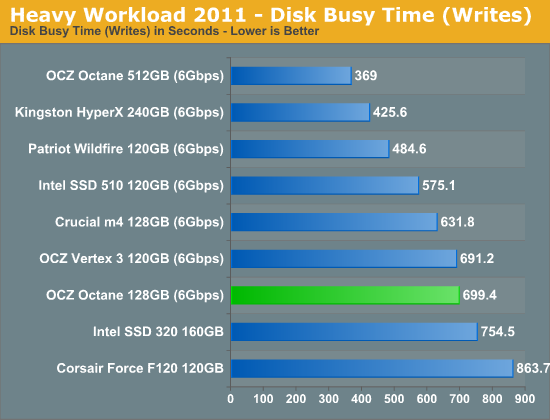










38 Comments
View All Comments
Xpage - Wednesday, December 28, 2011 - link
Thank you for the review on a model that is more down to earth on its cost.JonnyDough - Wednesday, December 28, 2011 - link
I second that. I'm glad you went with a lower capacity model. I wish you had included a first generation Vertex drive, along with a second for scaling. It may be SATA II, but I'm still using Vertex 2 drives and I would like to see just how modern drives compare.Also, it seems to me that the best middle of the road performer here is Patriot's Wildfire drive.
realjetavenger - Wednesday, December 28, 2011 - link
I was thinking the same thing. The Kingston HyperX and Patriot Wildfire are at the top of most of the charts and seem to be the real winners here.harshw - Wednesday, December 28, 2011 - link
Hi AnandWill you be reviewing mSATA SSDs at any point ? It's the same thing with them - limited PCB space meaning 2-4 NAND chips => much less performance. I'm looking to add some mSATA SSDs to my HTPC and laptop, but where the vendors advertise insane performance, the forums tell another story :)
Rick83 - Wednesday, December 28, 2011 - link
A little tip: For small devices go for SLC NAND. That way you still get decent performance (and life-time - with little space there are less replacement blocks, and only so much load-leveling you can do) out of small devices, while only paying about ~2.5x as much - which at the small volumes isn't so dramatic.harshw - Wednesday, December 28, 2011 - link
The cheapest for 20GB SLC mSATA is £100 - that's the Intel 311 series. Is there a 40GB SLC mSATA ? Can't seem to find anyIn any case a Kingston mSATA 60GB with the Phison controller nets for £75 and the OCZ Nocti 60GB with the Sandforce controller is £90~£100. The OCZ Strata 60GB with the Indilinx Eco controller is also around £75 but since there are no reviews and proper tests, can't really figure out which one to buy ...
Rick83 - Saturday, January 7, 2012 - link
Small devices for me are in fact up to 20 GB (I'm running two 8GB SSDs, where MLC might fall short). Above that, there is usually enough space to do decent wear leveling. (Wear is a function of the amount of writes per write block, hence the same amount of data written to a small drive over the same time, means more writes per cell, given the same level of write amplification)It depends on your use case as well - for hybrid-caching or silencing down a HDD by putting the swap file on flash, SLC is probably the better choice, but for portable applications, MLC always wins due to size being more important than performance.
Ammaross - Wednesday, December 28, 2011 - link
They've already benched the Intel mSATA devices. I'd go with MLC simply for cost effective reasons. In a year or two if you even are remotely worried about your NAND life, go buy another drive with the now twice the capacity and half the price.... (btw, NAND lifespan isn't near as important as it used to be. You're far more likely to drop-kick your Atom CPU well before your NAND dies).Samus - Wednesday, December 28, 2011 - link
You are so sexy!Tchamber - Wednesday, December 28, 2011 - link
I liked your comment about how many Velociraptors we could RAID for the price of an SSD. I have two 300gig 'Raptors in my desktop, backed by an i7 970. Funny thing, my Core 2 Quad latop with and Intel SSD 320 120gig feels every bit as snappy, even better when booting or loading PSE. I should put the SSD in my desktop for a day and see what my file transfers would be.